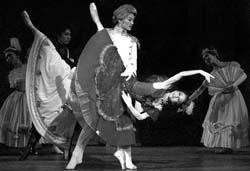65 dancers, two truckloads of stage props, and “Soviet” ballet

On January 15-17 the National Opera of Ukraine hosted the Japanese troupe Ballet Chambre West. The tour was organized by the firm Antrepriza and the Japanese performers came with their production Tatyana based on Pushkin’s Eugene Onegin and Tchaikovsky’s music. After that the Japanese troupe left on a tour of Moscow and St. Petersburg.
The Japanese fell in love with classical ballet thirty years ago and have since eagerly learned from Slavic choreographers at home and at leading schools in Russia, Ukraine, and Belarus. In the last third of the twentieth century Japan had actually become a ballet country with a first-rate troupe (one is reminded of the Tokyo Ballet’s tour of Kyiv), hosting prestigious international contests and ballet stars, some still with reputed Western companies. In 1990, Tokyo Ballet General Director Tadasugu Sasaki said at a press conference commemorating the company’s 30th anniversary that they had to invite Europeans to stage national ballets, but that they did only those they felt completely confident about — above all Maurice BОjart who staged several Japanese ballets, including a traditional Kabuki production titled M about Yukio Mishima, and also John Noimayer and other celebrities. Japanese choreographic thought, however, did not seem to have reached further than the kimono. Not until the Ballet Chambre West appeared in Kyiv, Roman Yefimov, Antrepriza CEO, described the troupe as a markedly original one. Its 65 dancers performed with the National Opera’s symphony orchestra and their production Tatyana turned out to be most interesting. Technically sophisticated (two truckloads of stage props, diversified video effects, and refined wardrobe), the production showed that the authors were very meticulous in conveying the fashion and spirit of Pushkin’s poem.
The troupe’s name, Chambre West, comes from its base to the west of downtown Tokyo. The troupe was founded fourteen years ago and has specialized in classical ballet as well as original productions by artistic director Hiroaki Imamura (jointly with Yuriko Kawaguchi, head of the Chambre West’s ballet school, both also being premier danseurs).
Chambre West has produced twelve premieres over the years. Their repertoire boasts Tchaikovsky’s Nutcracker, Spanish Ballet (based on Adam’s Giselle), Tchaikovsky’s Swan Lake, the dance scene from Bizet’s opera Carmen, Prokofiev’s Cinderella, Delibes’ Coppelia, the dance scene from Verdi’s Traviata, M. Isidzima’s Heavenly Poem, Dziro So’s Saige under the Rain, Isidzima’s Northern Light, S. Amano’s On the Road — all praised by critics and habituОs.
The troupe tours Japan often and in force, taking part in international festivals. Three years ago Chambre West performed at the Bolshoi (Moscow), Aleksandrinsky Theater (St. Petersburg), and the National Opera of Estonia (Tallinn).
Two years ago, Hiroaki Imamura and Yuriko Kawaguchi staged Tatyana, in collaboration with the Russian production designer Vyacheslav Okunev and stage prop firm Vozrozhdeniye (St. Petersburg).
Naturally, exacting ballet habituОs, knowing that classical Japanese ballet is intrinsically traditional, may feel skeptical about such experimenting with Russian classical pieces. They should remember, however, that tradition implies affection for those whose example one wants to follow. In other words, what the Japanese performers did was a very interesting interpretation of Eugene Onegin. Incidentally, this opera has never before been staged as a ballet. Moreover, Japanese industriousness is generally known, hence their spectacular progress in the arts. Chambre West’s female dancers show good technique and refined dramatic identification. The male performers demonstrate the whole set of supports and leaps in duets and crowd scenes, matching every European standard. Considering that Japanese dancers received the first lessons in classical ballet only fifty years ago from Russian teachers, their absorption in dramatic ballet and choreographic generalizations popular in the Soviet Union in the 1960s to 1970s is not surprising. The language of gestures, basic ballet pas, plus dancers as allegories are the Chambre West’s favorite approaches.






